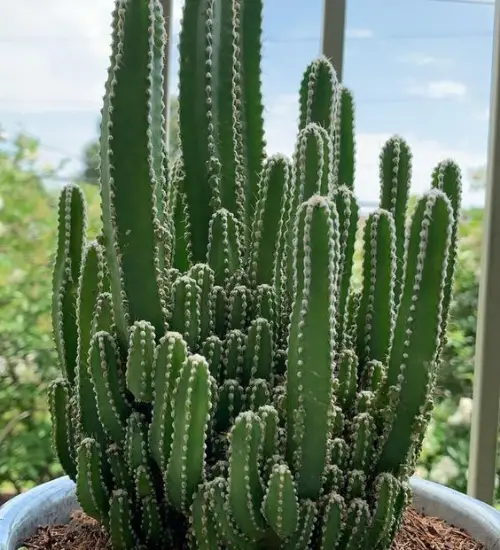Sun: Partial sun to partial shade
Water: Typical water needs for a succulent
Temperature: Zone 10b from 35° F to 40° F (1.7° C to 4.4° C)
Winter Survival: Not cold hardy
Propagation: stem cuttings, seeds
Flower: rarely
Flower Type:
Toxic: Generally non-toxic to humans and animals
Dormant: winter
Space Requirement: Indoors & Outdoors
Common Problems: Plants may rot if overwatered, Fungal diseases, pests
Where to buy Acanthocereus tetragonus?
Basc Care for Acanthocereus tetragonus
Watering
Regular watering period should be every 2 weeks
You can water your succulent more than often in extreme conditions but make sure that the soil is completely dry before watering your succulent again.
One simple tip for you is that you can use some online apps to check the soil status before you go water your succulents. I would recommend the ThePlantsCheck app, it has some nice features there.
Fertilizing
Only feed this succulent during its active growing seasons which means spring and fall. Use the right fertilizer applied in the right amounts. Applying half-strength balanced fertilizer every month or so is recommended for optimal results.
Sun & Location Requirements for "Fairy Castle Cactus"
When it comes to finding a spot for Acanthocereus tetragonus, partial sun and shade is best. This means it should get four to six hours of direct sunlight with some additional protection from the midday sun. This will ensure your succulent receives the right amount of light to stay healthy and happy!
As per this succulent profile, it is only able to stay healthy when the environment temperature is above the range of zone 10b from 35° F to 40° F (1.7° C to 4.4° C).
When temperatures drop below freezing, it is important to take precautions to protect Acanthocereus tetragonus from the cold. Insulating and providing adequate drainage for the plant are key elements in helping it survive winter weather. Wind and sun exposure should also be minimized to prevent frost damage.
In order to ensure that Acanthocereus tetragonus survives the winter, insulation and drainage are essential. A layer of mulch or gravel around the plant can help keep the roots warm during cold temperatures. Furthermore, avoiding exposure to wind and sun can reduce the risk of frost damage and promote longevity for your succulent.
Any succulents in the group will need a medium space to grow. You can place your pot at your table or window. Since this plant needs more space than mini succulents, you should consider do not plant them together with other succulents/plants.
Propagation
Propagating Acanthocereus tetragonus by stem cuttings is an easy and fun way to increase your collection of these unique houseplants. When propagating, it’s important to choose healthy stems from existing plants that are at least two inches long and have several leaves attached.
Propagating Acanthocereus tetragonus from seeds is a great way to produce new plants without relying on cuttings or divisions. It's important to look for healthy, dark and plump seeds that are slightly sticky when touched. The soil should be pre-mixed with well-draining potting mix, before evenly sowing the seeds and pressing them into the surface. To ensure successful germination, gentle misting of the soil should be done and placed in indirect light.
Toxicity

Acanthocereus tetragonus is generally thought to be non-toxic for humans and animals. However, it is important to note that certain parts of the plant may contain toxins which can cause mild skin irritation if ingested or touched. For this reason, the plant should always be kept away from children and pets.
Pests and Diseases
If you do spot any of pest signs, you can treat your succulent using below methods.
- Bugs: quarantine, systemic insecticidal/soapy water.
Besides that, to prevent serious health issues from happening, keep your succulent in a well-ventilated area and check it regularly for any signs of pests or health problems.


